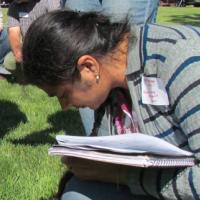
Research Focus:
Predicting for important bioclimatic variables for REACCH agroecological classes
Research Abstract:
Climate change is expected to impact geographic suitability of different cropping systems. First chapter objectives were to: (1) establish empirical relationships between bioclimatic variables and current agro-ecological classes (AECs) in the inland Pacific Northwest (iPNW) using Random Forest (RF); and (2) use projected climate change effects on bioclimatic drivers to assess shifts in current AECs. Bioclimatic variables identified as important in RF modeling of AECs were Holdridge evapotranspiration index, spring precipitation, and precipitation of the warmest 4-months which had an overall model accuracy of 69%. Super-imposing projected changes in bioclimatic variables for Representative Concentration Pathway of 8.5, 2070, on current AECs showed a 58% increase of dynamic annual crop-fallow-transition (AC-T) and a 63% increase for dynamic grain-fallow (GF) AECs. Stable AC-T and dynamic annual crop (AC) AECs decreased by 46%, while least decline occurred under stable AC and GF. Increased annual fallow would negatively impact soil resources, while increases in dynamic AECs would promote flex-cropping.
Greater future uncertainty in weather extremes could promote the use of flex-cropping. Second chapter objectives were to: (1) use CropSyst model to simulate spring wheat (SW), spring canola (SC) and spring pea (SP) yields based on historic weather as well as in combination with representative year weather at different pre-plant forecast dates; and (2) conduct regional simulations using selected pre-plant forecast dates to develop regional yield and available water maps. Simulations of fallow water use efficiency showed a regional range of 3 to 71%. Simulated yields were largely influenced by pre-plant as compared to post-plant precipitation. Model projections improved as simulations based on historic weather incorporated current year weather and identified Feb. 1st as a suitable time to predict regional yield and available water. Regional spring crop yield forecasts displayed substantial extremes for a representative year ranging from 1-4367 kg/ha for SC, 72-2646 kg/ha for SP and 39-5330 kg/ha for SW. These data combined with estimates of available water, winter wheat yield reduction and economic information would aid decisions regarding flex-crop choices. Recommendations included establishment of a regional network of field locations linked to simulation modeling to further corroborate model results and promote use.
Publications and Presentations:
Kaur, H., Huggins, D.R., Rupp, R.A., Abatzoglou, J.T., Stockle, C.O., Reganold, J.P. 2017. Agro-ecological Class Stability Decreases in Response to Climate Change Projections for the Pacific Northwest, USA. Frontiers in Ecology and Evolution-Agroecology and Land Use Systems, doi: 10.3389/fevo.2017.00074.Kruger, C., Yorgey, G. 2017. Advances in dryland farming in the Inland Pacific Northwest. Washington State University Extension EM108.
Kaur H., Huggins, D.R., Rupp, R.A., Abatzoglou, J.T., Stӧckle, C.O., Reganold, J.P. 2017. Future Bioclimatic Drivers Increase Uncertainty of Dryland Agro-ecological Classes of the Inland Pacific Northwest, USA. Frontiers in Ecology and Evolution 5, Article 74.

